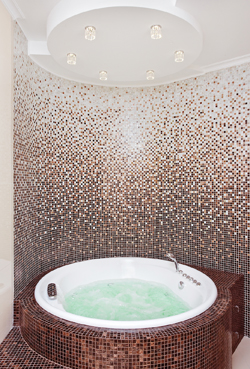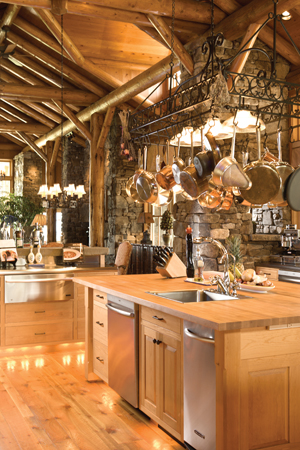For many, building a log home is a dream come true, an opportunity to settle into a long-sought lifestyle combining the finest in comfort with the pristine beauty of nature. Making the most of this building project that may occur only once in a lifetime means research, quality shopping, and informed decisions.
No aspect of the decision-making process is as challenging as that of balancing comfort, décor, and cost. Therefore, the inclusion of amenities is the subject for detailed discussion. Particularly in today’s economy, the wow factor of such options as a swimming pool, tennis court, water feature, mind-blowing landscaping, bonus room, granite countertops, and top-of-the-line appliances is tempered by the investment required to achieve that most impressive look and feel.
“Typically, amenities packages are put together as an incentive to buy someone’s product or services,” relates Greg Landess, vice president of sales and marketing for Blue Ridge Log Cabins. “The amount a customer pays for these amenities is usually less than buying the items individually; therefore, creating a value or savings for the customer. An amenities package is only successful if it has a ‘value’ to the individual consumer. Amenities packages can be great, but be careful not to let them overshadow the whole project.”
Besides, some amenities may be more practical than others. When it comes to a bonus room, for example, space may always be at a premium and it is usually true that it is cheaper to finish a project on the front end rather than endure the disruption and expense of an addition later. Then, there are those pure upgrades that make a home more livable and offer some eye candy to the observer. A jetted tub is, for the most part, a given amenity these days, while the gleam of granite or marble provides the eye candy that solid surface can seldom deliver.
“It is certainly wise to invest in some amenities over others,” advises Joshua Beasley, marketing director of Honest Abe Log Homes in Moss, Tennessee, “and we have found what directs that wisdom has little to do with how they affect resale value but has everything to do with lifestyle. This probably doesn’t hold true at all within the conventional home market, but for log homes many of our clients enter into the process expecting it will be the last home they ever build. They simply want amenities to fit their lifestyle.”

While log home builders and buyers are realistic about the slim prospect of getting a dollar for dollar return on their amenities investment when and if it comes time to resell, there is that expectation—or maybe a glimmer of hope—that some value will be recaptured when a property changes hands. However, those who pay for amenities regularly do so to reflect personal preference, ease of living, and space utilization that display individuality and convenience.
“In our current market, it all comes down to balancing practicality and lifestyle,” related Beasley. “Our clients are watching every penny they spend, balancing need and comfort along with their long-term financial plan. We are seeing less high-end components throughout, but that doesn’t mean customers are not spending money on amenities. Instead, they seem to focus their extra spending around their personal lifestyles rather than having a concern over how it may affect resale value down the road.”
Practical considerations are more important than ever before to the amenity-conscious log home builder or purchaser. Individual perspective is the prime mover in determining whether a certain feature is an extravagance or an absolute must. The relative value of an amenity is absolutely in the eye of the person paying the freight.

“Pick items that are of value to you and your family,” offers Landess, “or talk with a real estate professional if you are concerned with resale values. A pool may be great for you, but not for the next buyer of your home. Also make sure you understand any and all future costs associated with your amenities package, such as maintenance fees, dues, life expectancy, and installation costs.”
Beasley advises, “We are seeing fewer bonus rooms simply because they are rarely used. During the same period, our customers have channeled amenity investments to fuel their interests. We have seen more outdoor living spaces and more money spent on certain rooms within the log home that the client feels drawn to. For one customer, it may be an incredibly well furnished and equipped great room, and for another it may be an exterior fireplace and kitchen located with a screened-in porch.
“Amenities are often trend driven,” he continues. “While they can definitely increase appeal and value in an existing home, that same value probably cannot immediately be realized with new construction right now. The majority of our log home clients have no intention of selling their log home anyway.”
Playing the amenities game can be fraught with pitfalls for the log home owner. Proceed with caution and give construction options careful consideration, making the choices that best fulfill personal needs and wants. Avoid incorporating the latest fad or whim. Make sure that the amenities chosen reflect the comfort, presentation, and purpose intended. Certainly, making the right decision in the beginning means a little less angst over the finished project.

